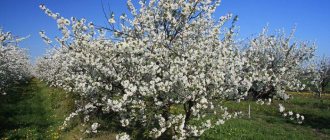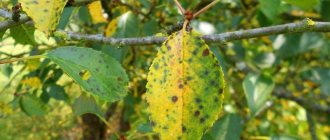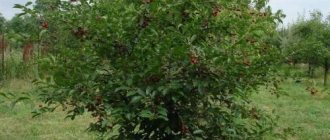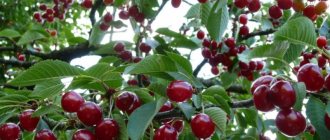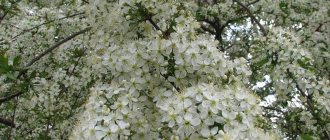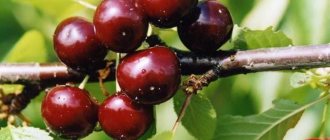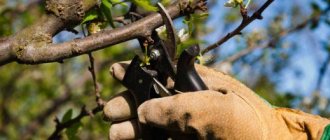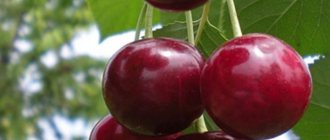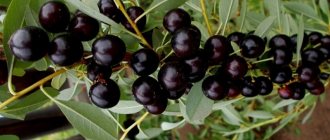Anthracite cherry: description of the variety and characteristics
Anthracite cherry: photo of variety
The common Anthracite cherry variety was bred for cultivation in the central Russian regions; due to its characteristics, the variety is suitable for cultivation in almost all areas.
The Anthracite cherry tree has a spreading and raised crown, reaching a height of up to two meters. Branches are sparse. The buds are small, cone-shaped, their length is three mm, pressed against the branches. The leaves are dark green in color, small, serrated, grow up to six to seven cm in length, wide, elliptical, pointed at the apex, rounded at the base. The surface of the leaf plate is shiny, curved, and there are pronounced veins on the inside. The petiole is elongated, up to twelve cm, rich in anthocyanin. The inflorescence is umbellate, contains three to five flowers, they are 2.3 cm in diameter, the petals are white.
Anthracite cherry berries are heart-shaped, the fruit funnel is wide, the top is rounded. The fruit stalk is shortened, the average length is eleven mm. The average size of a cherry is twenty-one by sixteen mm, the internal contents are fourteen mm thick. The weight of the fruit is 4.1-5 grams. The peel is dense, but thin; when the berry is ripe, the color of the skin becomes rich dark red, almost black. The bright colors of the fruit gave the variety its name.
The internal contents of the berries are juicy, sweet and sour, dark red in color, medium dense. The fruits contain sugar (11.2%), acid (1.63%), dry matter (16.4%). The seed is yellow-cream colored, the ratio to the weight of the fruit is only five and a half percent, weighs 0.23 grams, it can be easily separated from the pulp. According to this feature, the variety is comparable to cherries. The decorative quality of the berries is rated highly – 4.9 points. The tasting score is 4.3 points.
Reviews from gardeners
“A very decent harvest for such a small cherry. The only thing I don't like about it is that the ripe fruits burst. You have to pick them without waiting for complete ripeness, but they ripen well even separately. But the pit comes off almost like a cherry, it doesn’t even look like a cherry. By the way, the pulp of the berries is very well suited for squeezing juices - it’s not too dense and juicy.”
“This variety does not have very deep roots, so when planting, bury the cherry more deeply than usual. I immerse it in the hole to about half the length of the seedling so that it grows a stronger root system. Then it is easier for the bush to withstand gusts of wind. But in any case, it is better to plant Anthracite in a secluded place where there are no drafts. My first seedlings died, I think it was precisely because of the shallow planting and the poor location.”
If it is possible to provide reliable protection against diseases, the “Anthracite” variety will prove to be a problem-free and productive cherry with beautiful and tasty berries. Unpretentiousness, the ability to tolerate drought and winter without shelter have made “Anthracite” one of the most popular dwarf varieties among gardeners.
Juicy, tart, aromatic cherries are loved and planted in areas of southern Russia, Siberia and western regions. For some reason, sometimes it seems that in gardens under constant supervision, with acidity control, plenty of fertilizers and regular watering, the harvest is unpredictable, but next to the fence a lonely cherry grows. The branches are not pruned, the crown is not formed, the trunk is not whitened, but every year it is strewn with berries.
In the description of cherry varieties there are the concepts self-fertile, partially self-fertile and self-sterile. In self-fertile varieties, approximately 40% of the flowers are fertilized. In partially self-fertile varieties this figure is not higher than 20%. Self-sterile cherry varieties in the absence of pollinators can produce no more than 5% of the ovary of the total number of flowers.
For fertilization, the flower needs stamen pollen to land on the stigma. Mechanically, pollen transfer can be carried out by insects, wind, with human participation, or without intermediaries in self-pollinating plants. In this case, pollination occurs within one flower or plant.
When self-pollinating, plants are at a disadvantage because virtually no genetic information changes. The main qualities for survival - variability and adaptability - are obtained through cross-pollination due to various combinations of parental genes.
Hence the definition of “self-sterile.”
Self-sterile varieties need the proximity of other varieties of cherries and even sweet cherries. At the same time, other trees of the same variety will also not be pollinators.
Self-fertile cherries differ in the structure of the flower: the anthers of the stamens are at the level of the stigma of the pistil or slightly rise above it.
The anthers of the stamens of self-fertile cherry varieties rise slightly above the stigma of the pistil
The advantage of self-fertile varieties is that you can limit yourself to one tree within the garden plot.
Some independence from weather conditions and pollinating insects, as well as the small size of the trees, distinguish these varieties. Gardeners and experts note that with pollinating trees growing nearby, the yield of self-fertile varieties increases significantly. And it’s also worth paying attention to the taste.
As a rule, self-fertile cherries have a pronounced sourness, and sometimes they can be consumed only after processing.
Stone fruit specialists highlight the main characteristics of self-fertile cherry varieties:
- winter hardiness;
- disease resistance;
- ripening time;
- productivity;
- taste and size of berries.
In small garden plots, the height of the trees and the shape of the crown are also important.
Read more: Breed Fat-tailed sheep review how to contain photo description
Recently, climate changes, which have led to milder winters and prolonged rains during flowering, have led to an outbreak of fungal diseases of stone fruit, coccomocosis and moniliosis. The efforts of breeders are aimed at developing new varieties with increased resistance to disease and cold.
An outstanding domestic pomologist, Maina Vladimirovna Kanshina, has created cherry varieties that are distinguished by exceptional hardiness, while being productive and self-fertile. Received from the All-Russian Lupine Research Institute in Bryansk, they have taken root and are growing in gardens in the Moscow region.
Bryansk Shpanka
The resistance of flower buds to frost sets this variety apart, ensuring stable yields. The fruits ripen early. On average, 11 kg of berries are harvested from a tree, and the maximum harvest reaches 18 kg of delicate pink cherries. The berries are smooth, average weight about 4 g, and come off the stem easily.
Trees of medium height. Disease resistant. Self-fertility and high yield distinguish this variety.
Bryansk shpanka is distinguished by exceptionally high winter hardiness of flower buds
Radonezh
The trees are characterized by low growth, high resistance to cold and fungal infections. In terms of ripening, they are mid-season. The yield is usually 5 kg of berries per tree; with favorable weather and good care, it reaches 9 kg. The berries are dark cherry, sweet taste with slight sourness, weighing on average just over 4 g.
Radonezh cherry is a small tree of medium ripening
Fad
The tree grows quickly, but does not exceed medium size. Shows moderate winter hardiness. Mid-season dessert variety. The peculiarity of this cherry is its special sensitivity to coccomycosis.
Although the leaves may be affected by the disease, they do not fall until autumn. The quality of the fruit is exceptional, the taste is excellent, the sweetness is harmoniously combined with sourness. The berries are dark to black, the average fruit weight is 5.1 g.
The yield is usually 6 kg of berries per tree, but can reach 8–9 kg per plant. Partially self-fertile variety.
Cherry Whimsy produces amazingly tasty berries
Shy
An amazing variety that has revealed its potential in unfavorable conditions. M.V. Kanshina calls this cherry “hard worker.” Late ripening, demonstrates stable fruiting. A tree of medium height, with a compact spherical or slightly spreading crown.
The berries are universal, suitable for use in fresh and canned form. The peel and pulp are very dark, almost black, the juice is rich dark red. The average fruit weight is 4.5–6.5 g. The taste is noble, sweet and sour.
Tasters give these berries a maximum five-point rating.
The advantages of Shy cherries include winter hardiness and some resistance to major stone fruit diseases. Self-fertility is partial. The average yield is more than eight kilograms of berries per tree; with careful care, it reaches 11 kg.
Cherry Shy, reliable and productive
Among the self-fertile cherries that exhibit resistance to diseases and unfavorable external conditions, it is worth remembering the varieties with a short stem.
Igritskaya
Late ripening. Short-trunked and fast-growing tree. The crown is initially spreading and later droops. Fruits every year. The berries are ruby, average weight 4.2 g. The taste is sweet and sour, the fruits are universal in the method of use. Self-fertility is well expressed. The average yield is more than 8 kg of berries per tree, the maximum reaches 13.7 kg.
Late Igritskaya cherry for universal use
Morel Bryansk
Low-growing cherry with a short stem. Very late, winter-hardy. The fruits are dark red, sometimes almost black, the flesh is lighter. The berries weigh on average 4.2 g, but can be larger, up to 5–6 g. They have a rich sweet and sour taste. Very weakly affected by diseases. On average, 8.3 kg of berries are harvested from one tree, the maximum yield reaches 11 kg.
Morel Bryansk is low-growing, but productive and very resistant to disease
Bystrinka
Bush-type cherry with a thickened spherical crown. Obtained in the Oryol region, at the All-Russian Research Institute of Fruit Crop Breeding. The berries ripen in medium terms, are small in size, dark red, with delicate pulp of excellent sweet and sour taste. The use of berries is universal. Average fruit weight is 3.6 g.
The variety is resistant. Productive, with the small size of the plant itself it reaches 7.4 kg of berries per tree. Partially self-fertile.
Bystrinka cherry is small and productive
Mtsenskaya
Low-growing cherry with an oval crown. Medium-late ripening, the originator is the same as that of the Bystrinka cherry. Round dark berries of small size, with an average weight of 3.4 g.
The pulp is juicy, dark red, sweet and sour. Berries of universal use. The variety is winter-hardy, partially self-fertile. The average yield is 7 kg of berries per tree.
Mtsenskaya cherry shows resistance to moniliosis.
Mtsensk cherry is compact, productive and decorative
Anthracite
Low-growing, medium-late cherry of the Oryol selection. It rarely grows more than two meters in height. The berries are dark burgundy, almost black. The pulp is juicy, dark red. The taste is very pleasant, sweet and sour, the average fruit weight is 4 g. The yield is excellent. Winter hardiness is high. Drought resistance and resistance to fungal diseases is average. The variety is partially self-fertile.
Anthracite cherry produces almost black berries with excellent sweet and sour taste
Youth
The cherry is low-growing, bush-type. Received from the Federal State Budgetary Institution "All-Russian Selection and Technological Institute of Horticulture and Nursery Growing." Medium late variety. The fruits are medium-large, weighing more than 4.5 g. The berries are dark burgundy, with juicy dark pulp of a pleasant sweet and sour taste. Productivity is stable, annual. The variety is self-fertile. Winter-hardy. Moderately resistant to coccomycosis.
Cherry Youth bush-like, self-fertile and productive
Low-growing trees are very attractive in small gardens and are successfully used as landscape elements. In addition, compact plants can be easily protected from feathered robbers and harvested almost entirely without the use of ladders or ladders.
Cherry in garden design pleases the eye and provides fragrant berries
Sweet varieties
Among self-fertile cherries, truly sweet varieties are rarely found. Of the varieties considered, the varieties Prichuda, Morel Bryanskaya and Igritskaya have the sweetest fruits. But still, the Shy cherry berries have the maximum tasting score, since the sweetness in its pulp is combined with a deep aroma and delicate sourness, creating a unique bouquet.
Memory of Enikeev
Anthracite cherry: characteristics of the variety
The Anthracite common cherry variety differs from other cherry varieties in that it has inherited most of the benefits from the parent cherry.
Resistance to dry and winter periods.
- The Anthracite cherry variety is able to withstand the winter seasons that are typical for mid-Russian latitudes. Cherries adapt well and will bear fruit in the Moscow region. But the culture will not tolerate very low, long-term temperature conditions.
- It is advisable to place the tree near buildings that protect it from harsh winds.
- The Anthracite variety of common cherry is resistant to dry periods of short duration. To get a good yield, timely watering is carried out in the furrows that are made in a circle around the crown.
Pollinators, flowering, ripeness.
- A characteristic feature of the mid-ripening Anthracite cherry is that it is partially self-fertile. Even from a single cherry you can collect some fruit. The yield will be more generous if the following cherry varieties are planted nearby: “Vladimirskaya”, “Nochka”, “Lyubskaya”, “Shubinka”, “Shokoladnitsa”. Experienced gardeners recommend planting cherry trees nearby.
- The variety continues to bloom from the 10th to the 15th of May. Fruit ripening occurs after the fifteenth to twenty-third of July, here everything depends on the climate.
Yield indicator, fruiting.
The formation of ovaries occurs on bouquets, twigs and shoots of the previous year. Fruiting begins in the fourth year after planting. It must be borne in mind that the tree is short-lived: its fruiting lasts about fifteen to eighteen years. If you properly care for, water in a timely manner and properly feed the cherries, the yield will be up to eighteen kilos of fruit. During the trial period, the tree showed an average yield of 96.3 centners per hectare.
The record is 106.6 centners per hectare, which suggests good productivity of this cherry variety.
Where are Anthracite cherry fruits used?
The fruits are eaten fresh, and various compotes and jams are also prepared from them. In addition, cherries are frozen and dried.
Immunity to diseases and harmful insects.
The Anthracite common cherry variety can infect moniliosis and coccomycosis at an average level. The plant must be inspected during the growing season in order to detect harmful insects earlier: aphids, codling moths, cherry flies.
Features of wintering a tree
This fruit crop is considered winter-hardy; due to its frost resistance, it thrives in cold weather, so it does not require any preparation for the winter period. The only thing the gardener needs to take care of is laying mulch in the tree trunk circle; sawdust is suitable as a material.
As you can see, there is nothing complicated in growing Anthracite cherries. But the reward will be tasty and juicy fruits that taste like cherries. To do this, it is enough to provide the trees with a good sunny place, regular watering and timely application of fertilizers.
Advantages and disadvantages of the Anthracite cherry variety
Anthracite cherry: photo of variety
The Anthracite cherry variety has already become quite popular in the center of Russia, and has also become widespread in other regions, as it has its own advantages.
- High marketability: decorative fruits, thick internal contents, excellent taste.
- The berries are well transported.
- High yield.
- Partially self-fertile.
- Resistance to winter, resistance to dry periods that do not last long.
Disadvantages of Anthracite cherries.
- Average resistance to fungal infections such as coccomycosis, moniliosis.
- Instability to harmful insects.
- The yield will be greater and the fruits will taste sweeter if the tree is planted in a place that is well lit by sunlight.
Anthracite Cherry: planting
To enjoy the harvest, you need to correctly select the site and time for planting cherries.
Optimal time.
A seedling with bare roots adapts well only in the spring season. Container cherries are planted before the first autumn month.
How to choose a suitable site.
- Placing the tree in the south of the buildings is the best option. Windy areas should be avoided.
- The cherry tree is not planted where there is stagnant water and in low-lying areas. Or the plant is placed on a hill.
- This cherry variety feels comfortable growing on loam and sandy loam with neutral acidity.
- Heavy soils are improved with sand, peat, and humus.
- Acidified soils are diluted with lime.
What plants are allowed and prohibited to be planted near a cherry tree.
A cherry or cherry tree is planted next to this variety. Good neighbors will be hawthorn, rowan, honeysuckle, elderberry, and currants growing in a semi-shaded place. It is prohibited to plant tall crops near cherries: apple, apricot, linden, birch, maple trees. It is also not recommended to plant raspberries, gooseberries, and nightshade plants near cherries.
When choosing crops for the neighborhood, you need to leave nine to twelve squares of land for cherries.
How to select and prepare material for planting.
- High-quality planting material is purchased from a special nursery.
- The best option is a two-year-old seedling.
- The trunk is sixty cm.
- The stem is two to two and a half cm thick.
- The branches should be up to sixty cm in length.
- The roots should be elastic and not damaged.
Planting material is transported from the place of purchase to the house by wrapping the roots in moistened fabric material. Next, the seedling is immersed in a clay mash for two to three hours. A drug is added to stimulate growth, see instructions.
Progress of planting work.
- A peg is driven into the prepared hole with the soil mixture in order to then tie a young plant to it.
- The seedling is placed on a hill, the roots are straightened.
- The root collar should rise five to seven cm above the surface soil layer.
- After watering, the soil is mulched (layer thickness is five to seven cm).
- The branches are pruned to fifteen to twenty cm.
Disembarkation process
Before planting on a summer cottage, it is recommended:
- Dig a hole about 50 cm deep and wide.
- Add fertilizer mixed with 10 liters of compost, which includes superphosphate, potassium chloride, wood ash in the proportion of 30 g: 40 g: 500 g.
- Fill half the hole with fertilizer.
- Pour 10 liters of water into the hole.
- Place a wooden peg in the center of the hole.
- Plant the seedling in the hole, carefully covering the root system with soil.
- Carefully tie the tree to a driven peg.
- Mulch using sawdust or peat.
It is recommended to feed cherries during abundant flowering at least 3 times a season.
The first fertilizing is nitrogen. It is carried out immediately after the soil has thawed. Made from:
- 10 liters of water.
- 20 g of urea or ammonium nitrate.
The next one is produced by organic fertilizers during abundant flowering.
- 10 liters of water.
- 0.2 liters of manure or 500 ml of ash.
The latter, using urea, is recommended to be done after fruiting, preferably in the evening.
Anthracite cherry: variety care
Anthracite cherry: photo of variety
When growing the Anthracite cherry variety, the soil is loosened to a depth of seven cm and weeds are removed. The cherry tree is watered once every seven days, ten liters in the morning and evening hours. It is important to water the tree after it has finished flowering and when fruit sets.
Watering stops when the fruits turn red.
Feeding is applied in the fourth or fifth year of development. Early in spring, urea or saltpeter is added. During flowering, cherries are fertilized with organic substances. After harvesting, spraying with urea solution is carried out.
Early in spring, weak branches that thicken the crown are pruned.
Before the winter season, the tree trunk circle is mulched. The trunk of a young tree is covered in several layers of agrofibre and mesh to protect it from mice and hares.
Features of planting and care
For good growth and fruiting of cherries, it is important that the climate of the growing region meets the requirements of the variety. Otherwise, additional care measures will be required, for example, shelter for the winter, and in some cases not only the yield, but also the rooting of the plant is questionable. If you grow Anthracite cherries in the conditions of the Central region, which has a suitable climate, the bush will require minimal care.
Landing
When choosing a place for planting, it is worth taking into account the low growth of the future bush. In order for this variety of cherry to receive enough sunlight, it must be located away from tall trees. It is also not worth planting in an area open to all winds; it is optimal if there is a house wall or a fence on the north side of the plant.
The variety loves loose, airy soils, does not take root well and grows on heavy soils, such as clay. Sandy loam or chernozem soil is best for cherries.
On a note! It is also possible to grow on loamy soil, but with regular care. The quality of such soil can be improved by adding peat, old sawdust and organic fertilizers.
Planting "Anthracite" is carried out according to the usual principle for cherries. It is important that the seedlings are healthy and strong, and that the roots in the hole are neatly straightened. Fertilizer is placed in the hole in accordance with the soil parameters, but lime and nitrogen fertilizers should not be placed. Experienced gardeners recommend dividing the planting watering into two portions: the first is poured into the hole when the roots of the plant are just covered with soil, and the second when the hole is completely filled.
Watering
Cherry variety "Anthracite" tolerates drought well. Excess watering is no less harmful for it than water deficiency. If the summer rainfall is average, no additional watering is required. But, like other varieties of cherries, drought in the periods after flowering and at the beginning of fruit growth can negatively affect the harvest. During these periods, it is necessary to control soil moisture.
Trimming
In this case, there is no need for pruning to limit the crown, but annual removal of diseased and weak branches is necessary. This will increase the flow of nutrients to the fruiting shoots and reduce the risk of pests and diseases.
To ensure a good harvest next year, it is important that the growth of shoots does not stop, since the bulk of the berries are set on last year’s branches. In view of this, annual shoots cannot be shortened, and weak growth on the branches indicates the need for rejuvenating pruning. In this case, the skeletal branch must be shortened to a strong side branch.
Top dressing
Fertilizing is applied according to the standard scheme for cherries:
- In early spring - nitrogen fertilizers (50-70 grams of urea or saltpeter per 1 bush).
- After flowering - organic fertilizer in liquid form (manure, compost).
- After 15 days, re-apply organic fertilizer.
- In the fall, during digging - potash (60-80 grams) and phosphorus (150-200) fertilizers in solid form.
Advice! For the “Anthracite” variety, additional foliar feeding with a 0.4% urea solution before flowering will not be superfluous. In addition to nutrition, this substance has the ability to destroy fungal spores.
Disease Prevention
Due to the lack of resistance of the variety to fungal diseases, you should not use fallen leaves and branches left over from pruning as humus. It is in the litter that fungal spores often overwinter. For the same reason, it is important to ensure regular removal of weeds around the bush, as well as to dig up the soil in the autumn, mixing the top layers of soil with wood ash.
Standard measures are used as treatment - treatment with a 3% solution of Bordeaux mixture and spraying with fungicides in the period after harvest or in the spring before the buds swell. Treatments undertaken after the cherry blossoms begin will poison the fruits; during this period, only natural remedies, such as a soap-ash solution, can be used.
Diseases and harmful insects of Anthrocytic cherry: how to fight, preventive measures
- Moniliosis (monilial burn). Symptoms: shoots, ovaries and leaves look as if they have been burned. How to fight: spray cherries with preparations containing copper early in the spring, after the flowering period, in the autumn season. Preventive measures: diseased branches are removed, fallen leaves and diseased branches are burned.
- Coccomycosis . Symptoms: red dots appear on the leaves, grayish mycelium accumulates below, the foliage wilts, and twigs and berries become infected. How to fight: spray the tree with fungicidal agents in the last days of flowering and after harvesting. Preventive measures: treat cherries early in the spring with Bordeaux mixture or copper sulfate solution.
- Aphid . Aphid colonies are located at the bottom of curled leaves. How to fight: treat early in the spring, after the flowering period, in the summer season with Inta-Virom, Actellik, Fitoverm. Preventive measures: spray with Fufanon in the spring season.
- Cherry fly. Spoilage of berries by larvae. Preventive measures: treat cherries after the flowering period with Fufanon.
Anthracite cherry: reviews about the variety
Alexander, 48 years old, Oryol region: “Anthracite cherry has been growing for me for 10 years, I purchased material for planting at the experimental station. My garden plot with cherries is old, there are enough varieties for pollination. Fruiting began in the third year, the tree produced 10 fruits. Berries are a real dessert. The Anthrocytic cherry tree grows from the south, under the sun's rays. The fruits are black in color and very sweet.”
Marina, 44 years old, Moscow region: “A couple of years ago we purchased cherry seedlings of the Anthracite and Shokoladnitsa varieties from a nursery and listened to advice. We take care and mulch with humus for the winter. It grows in a good area; we do not cover the trunk. During these winter seasons the trees were not damaged. We are expecting the first fruits this summer season; there are ovaries on several branches.”
Tatyana, 37 years old, Tula: “It’s a pity, but in our climate the young Anthracite cherry was damaged by a burn that season. The flowering was magnificent, then the tips of the branches began to wither and dry out. We sprayed with Horus, treated the tree with this preparation and treated the buds during this spring, then after the Anthracite cherry tree had bloomed. I hope the damage will be minimal."
Pollination of the variety
In fruit crops with a partial ability to self-pollinate and in the absence of additional sources of pollen, the ovary will form from no more than 15–20% of the flowers. The official description does not indicate suitable pollinators for Anthracite; other sources call the following varieties the best for this purpose:
- Vladimirskaya;
- Lyubskaya;
- Shubinka;
- Griot Moscow;
- Chocolate girl.
It should be taken into account that for bees to work effectively, the distance between trees should not exceed 40–50 meters.
Bees carry pollen over a distance of about 40–50 meters
